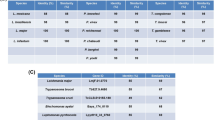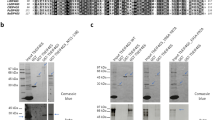Abstract
Protein translation leading to polypeptide synthesis involves three distinct events, namely, initiation, elongation, and termination. Translation initiation is a multi-step process that is carried out by ribosomes on the mRNA with the assistance of a large number of proteins called translation initiation factors. Trypanosomatids are kinetoplastidas (flagellated protozoans), some of which cause acute disease syndromes in humans. Vector-borne transmission of protozoan parasites like Leishmania and Trypanosoma causes diseases that affect a large section of the world population and lead to significant morbidity and mortality. The mechanisms of translation initiation in higher eukaryotes are relatively well understood. However, structural and functional conservation of initiation factors in trypanosomatids are only beginning to be understood. Studies carried out so far suggests that at least in Leishmania and Trypanosoma eIF4E function may not be restricted to canonical translation initiation and some of the homologues may have alternate/non-canonical functions. Nonetheless, all of them bind the cap analogs, albeit with different efficiencies, indicating that this property may play an important role in the functionality of eIF4Es. Here, I give a brief background of trypanosomatid eIF4Es and revisit the cap-binding signatures of eIF4E orthologues in trypanosomatids, whose genome sequences are available, in detail, in comparison to human eIF4E1 and Trypanosoma cruzi eIF4E5, with an expanded list of members of this group in light of newer findings. The group 1 and 2 eIF4Es may use either a variation of heIF4E1 or T. cruzi eIF4E5 cap-4-binding signatures, while eIF4E5 and eIF4E6 use distinct amino acid contacts.






Similar content being viewed by others
References
Stuart K, Brun R, Croft S, Fairlamb A, Gurtler RE et al (2008) Kinetoplastids: related protozoan pathogens, different diseases. J Clin Invest 118:1301–1310
Votypka J, Sukova E, Kraeva N, Ishemgulova A, Duzi I et al (2013) Diversity of trypanosomatids (Kinetoplastea: Trypanosomatidae) parasitizing fleas (Insecta: Siphonaptera) and description of a new genus Blechomonas gen. n. Protist 164:763–781
Blom D, de Haan A, van den Berg M, Sloof P, Jirku M et al (1998) RNA editing in the free-living bodonid Bodo saltans. Nucleic Acids Res 26:1205–1213
Jaskowska E, Butler C, Preston G, Kelly S (2015) Phytomonas: trypanosomatids adapted to plant environments. PLoS Pathog 11:e1004484
Zofou D, Nyasa RB, Nsagha DS, Ntie-Kang F, Meriki HD et al (2014) Control of malaria and other vector-borne protozoan diseases in the tropics: enduring challenges despite considerable progress and achievements. Infect Dis Poverty 3:1
Giordani F, Morrison LJ, Rowan TG, de Koning HP, Barrett MP (2016) The animal trypanosomiases and their chemotherapy: a review. Parasitology 143:1862–1889
Cullen DR, Mocerino M (2017) A brief review of drug discovery research for human African trypanosomiasis. Curr Med Chem 24:701–717
Vijayakumar S, Das P (2018) Recent progress in drug targets and inhibitors towards combating leishmaniasis. Acta Trop 181:95–104
Fairlamb AH, Horn D (2018) Melarsoprol resistance in African trypanosomiasis. Trends Parasitol 34:481–492
Cowell AN, Winzeler EA (2019) The genomic architecture of antimalarial drug resistance. Brief Funct Genomics 18(5):314–328
Cupolillo E, Pereira LO, Fernandes O, Catanho MP, Pereira JC et al (1998) Genetic data showing evolutionary links between Leishmania and Endotrypanum. Mem Inst Oswaldo Cruz 93:677–683
Flegontov P, Butenko A, Firsov S, Kraeva N, Elias M et al (2016) Genome of Leptomonas pyrrhocoris: a high-quality reference for monoxenous trypanosomatids and new insights into evolution of Leishmania. Sci Rep 6:23704
Alcolea PJ, Alonso A, Garcia-Tabares F, Torano A, Larraga V (2014) An Insight into the proteome of Crithidia fasciculata choanomastigotes as a comparative approach to axenic growth, peanut lectin agglutination and differentiation of Leishmania spp. promastigotes. PLoS One 9:e113837
Grybchuk D, Kostygov AY, Macedo DH, Votypka J, Lukes J et al (2018) RNA viruses in blechomonas (trypanosomatidae) and evolution of leishmaniavirus. mBio 9:e01932
Sonenberg N, Hinnebusch AG (2009) Regulation of translation initiation in eukaryotes: mechanisms and biological targets. Cell 136:731–745
Osborne MJ, Borden KL (2015) The eukaryotic translation initiation factor eIF4E in the nucleus: taking the road less traveled. Immunol Rev 263:210–223
Lazaris-Karatzas A, Montine KS, Sonenberg N (1990) Malignant transformation by a eukaryotic initiation factor subunit that binds to mRNA 5' cap. Nature 345:544–547
De Benedetti A, Graff JR (2004) eIF-4E expression and its role in malignancies and metastases. Oncogene 23:3189–3199
Niedzwiecka A, Marcotrigiano J, Stepinski J, Jankowska-Anyszka M, Wyslouch-Cieszynska A et al (2002) Biophysical studies of eIF4E cap-binding protein: recognition of mRNA 5' cap structure and synthetic fragments of eIF4G and 4E-BP1 proteins. J Mol Biol 319:615–635
Zuberek J, Kubacka D, Jablonowska A, Jemielity J, Stepinski J et al (2007) Weak binding affinity of human 4EHP for mRNA cap analogs. RNA 13:691–697
Ho JJD, Lee S (2016) A cap for every occasion: alternative eIF4F complexes. Trends Biochem Sci 41:821–823
Yoffe Y, Zuberek J, Lerer A, Lewdorowicz M, Stepinski J et al (2006) Binding specificities and potential roles of isoforms of eukaryotic initiation factor 4E in Leishmania. Eukaryot Cell 5:1969–1979
Lewdorowicz M, Yoffe Y, Zuberek J, Jemielity J, Stepinski J et al (2004) Chemical synthesis and binding activity of the trypanosomatid cap-4 structure. RNA 10:1469–1478
Reolon LW, Vichier-Guerre S, de Matos BM, Dugue L, Assuncao T et al (2019) Crystal structure of the Trypanosoma cruzi EIF4E5 translation factor homologue in complex with mRNA cap-4. Nucleic Acids Res 47:5973–5987
Joshi B, Lee K, Maeder DL, Jagus R (2005) Phylogenetic analysis of eIF4E-family members. BMC Evol Biol 5:48
Dhalia R, Reis CR, Freire ER, Rocha PO, Katz R et al (2005) Translation initiation in Leishmania major: characterisation of multiple eIF4F subunit homologues. Mol Biochem Parasitol 140:23–41
Freire ER, Dhalia R, Moura DM, da Costa Lima TD, Lima RP et al (2011) The four trypanosomatid eIF4E homologues fall into two separate groups, with distinct features in primary sequence and biological properties. Mol Biochem Parasitol 176:25–36
Tuteja R (2009) Identification and bioinformatics characterization of translation initiation complex eIF4F components and poly(A)-binding protein from Plasmodium falciparum. Commun Integr Biol 2:245–260
Yoffe Y, Zuberek J, Lewdorowicz M, Zeira Z, Keasar C et al (2004) Cap-binding activity of an eIF4E homolog from Leishmania. RNA 10:1764–1775
Freire ER, Sturm NR, Campbell DA, de Melo Neto OP (2017) The role of cytoplasmic mRNA cap-binding protein complexes in Trypanosoma brucei and other Trypanosomatids. Pathogens 6
Freire ER, Vashisht AA, Malvezzi AM, Zuberek J, Langousis G et al (2014) eIF4F-like complexes formed by cap-binding homolog TbEIF4E5 with TbEIF4G1 or TbEIF4G2 are implicated in post-transcriptional regulation in Trypanosoma brucei. RNA 20:1272–1286
Freire ER, Malvezzi AM, Vashisht AA, Zuberek J, Saada EA et al (2014) Trypanosoma brucei translation initiation factor homolog EIF4E6 forms a tripartite cytosolic complex with EIF4G5 and a capping enzyme homolog. Eukaryot Cell 13:896–908
Zinoviev A, Leger M, Wagner G, Shapira M (2011) A novel 4E-interacting protein in Leishmania is involved in stage-specific translation pathways. Nucleic Acids Res 39:8404–8415
Yoffe Y, Leger M, Zinoviev A, Zuberek J, Darzynkiewicz E et al (2009) Evolutionary changes in the Leishmania eIF4F complex involve variations in the eIF4E-eIF4G interactions. Nucleic Acids Res 37:3243–3253
Zinoviev A, Manor S, Shapira M (2012) Nutritional stress affects an atypical cap-binding protein in Leishmania. RNA Biol 9:1450–1460
Alsford S, Turner DJ, Obado SO, Sanchez-Flores A, Glover L et al (2011) High-throughput phenotyping using parallel sequencing of RNA interference targets in the African trypanosome. Genome Res 21:915–924
Meleppattu S, Arthanari H, Zinoviev A, Boeszoermenyi A, Wagner G et al (2018) Structural basis for LeishIF4E-1 modulation by an interacting protein in the human parasite Leishmania major. Nucleic Acids Res 46:3791–3801
Altmann M, Edery I, Trachsel H, Sonenberg N (1988) Site-directed mutagenesis of the tryptophan residues in yeast eukaryotic initiation factor 4E. Effects on cap binding activity. J Biol Chem 263:17229–17232
McCubbin WD, Edery I, Altmann M, Sonenberg N, Kay CM (1988) Circular dichroism and fluorescence studies on protein synthesis initiation factor eIF-4E and two mutant forms from the yeast Saccharomyces cerevisiae. J Biol Chem 263:17663–17671
Morino S, Hazama H, Ozaki M, Teraoka Y, Shibata S et al (1996) Analysis of the mRNA cap-binding ability of human eukaryotic initiation factor-4E by use of recombinant wild-type and mutant forms. Eur J Biochem 239:597–601
Marcotrigiano J, Gingras AC, Sonenberg N, Burley SK (1997) Cocrystal structure of the messenger RNA 5′ cap-binding protein (eIF4E) bound to 7-methyl-GDP. Cell 89:951–961
Rhoads RE (2009) eIF4E: new family members, new binding partners, new roles. J Biol Chem 284:16711–16715
Volpon L, Osborne MJ, Topisirovic I, Siddiqui N, Borden KL (2006) Cap-free structure of eIF4E suggests a basis for conformational regulation by its ligands. EMBO J 25:5138–5149
Ruszczynska K, Kamienska-Trela K, Wojcik J, Stepinski J, Darzynkiewicz E et al (2003) Charge distribution in 7-methylguanine regarding cation-pi interaction with protein factor eIF4E. Biophys J 85:1450–1456
Tomoo K, Shen X, Okabe K, Nozoe Y, Fukuhara S et al (2002) Crystal structures of 7-methylguanosine 5′-triphosphate (m(7)GTP)- and P(1)-7-methylguanosine-P(3)-adenosine-5′,5′-triphosphate (m(7)GpppA)-bound human full-length eukaryotic initiation factor 4E: biological importance of the C-terminal flexible region. Biochem J 362:539–544
Lama D, Pradhan MR, Brown CJ, Eapen RS, Joseph TL et al (2017) Water-bridge mediates recognition of mRNA cap in eIF4E. Structure 25:188–194
Freire ER, Moura DMN, Bezerra MJR, Xavier CC, Morais-Sobral MC et al (2018) Trypanosoma brucei EIF4E2 cap-binding protein binds a homolog of the histone-mRNA stem-loop-binding protein. Curr Genet 64:821–839
Dhalia R, Marinsek N, Reis CR, Katz R, Muniz JR et al (2006) The two eIF4A helicases in Trypanosoma brucei are functionally distinct. Nucleic Acids Res 34:2495–2507
Torres-Guerrero E, Quintanilla-Cedillo MR, Ruiz-Esmenjaud J, Arenas R (2017) Leishmaniasis: a review. F1000Res 6: 750
Cucunuba ZM, Okuwoga O, Basanez MG, Nouvellet P (2016) Increased mortality attributed to Chagas disease: a systematic review and meta-analysis. Parasit Vectors 9:42
Bhattacharya A, Corbeil A, do Monte-Neto RL, Fernandez-Prada C (2020) Of drugs and trypanosomatids: new tools and knowledge to reduce bottlenecks in drug discovery. Genes (Basel) 11
Shaw PJ, Ponmee N, Karoonuthaisiri N, Kamchonwongpaisan S, Yuthavong Y (2007) Characterization of human malaria parasite Plasmodium falciparum eIF4E homologue and mRNA 5′ cap status. Mol Biochem Parasitol 155:146–155
Funding
SD is currently supported by THSTI, India core funding.
Author information
Authors and Affiliations
Contributions
S. Das conceptualized and wrote the manuscript.
Corresponding author
Additional information
Publisher's Note
Springer Nature remains neutral with regard to jurisdictional claims in published maps and institutional affiliations.
Rights and permissions
About this article
Cite this article
Das, S. Taking a re-look at cap-binding signatures of the mRNA cap-binding protein eIF4E orthologues in trypanosomatids. Mol Cell Biochem 476, 1037–1049 (2021). https://doi.org/10.1007/s11010-020-03970-w
Received:
Accepted:
Published:
Issue Date:
DOI: https://doi.org/10.1007/s11010-020-03970-w




